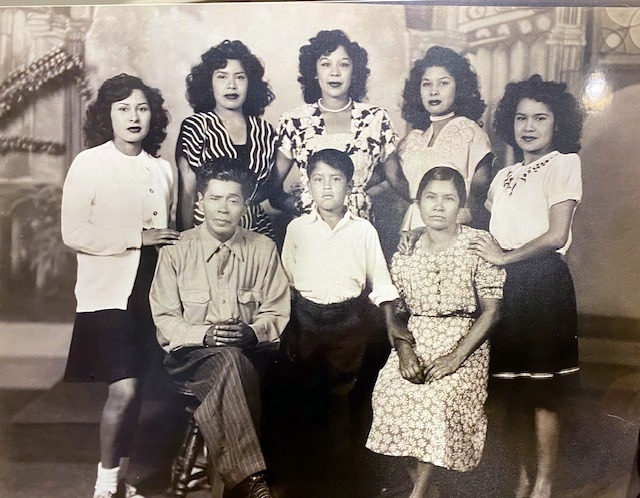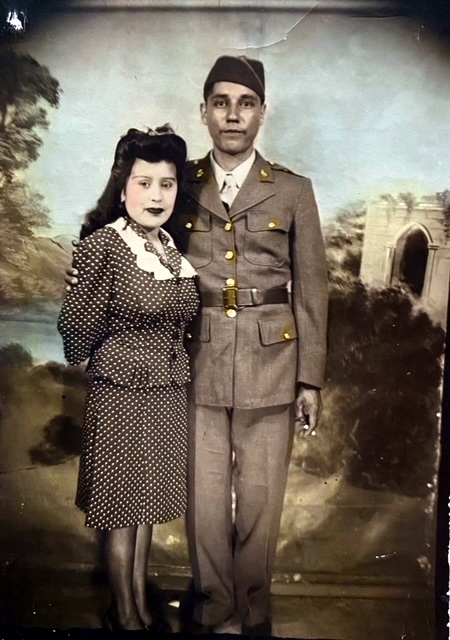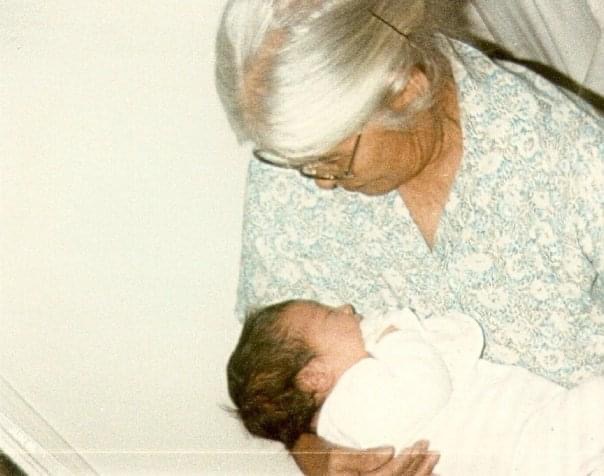|
Fillmore History Museum Shares the Story of the Cardona Family
By Gazette Staff Writers — Saturday, August 12th, 2023
 Pictured is the Cardona Family, circa 1945. Standing (l-r): Amelia, Loisa, Juana, Monica, and Pini; Front row: Marcos, Faustino, and Georgia. Photo courtesy Fillmore Historical Museum..  Pictured above are Guadalupe (Lupe) and Esquipula (Pula) Dominguez. Inset, Georgia Cardona holding the author of the story, her great-grand daughter, Christine. Photo courtesy Fillmore Historical Museum.  Courtesy Fillmore Historical Museum The Fillmore Historical Museum is partnering with Friends of Fieldworkers to capture and preserve the stories of the farm workers who have come to our valley in the past 100 years. Christine Cardona-Threadgill is one of the people spearheading this effort and the story of her family, who came to the valley in the 1920s, is showcased below. In the early 1920’s, Marcos Cardona, his wife Gregoria (aka Georgia) and two young daughters, Guadalupe (aka Lupe) and Juana (aka Jenny) made their way from Aguascalientes Mexico to the United States in search of a better future for their family. Two of Marcos’ brothers, Daniel and Maccimiano (Max), had already settled in Fillmore CA years before so upon arriving, Marcos and his family lived in Daniels home until finding their own residence. Marcos and Georgia would then have five more daughters, every two years or so: Eloisa (aka Elsie or Loisa), Epemenia (aka Penny or Pini), Monica, Esther (who died as an infant), and Amelia and then finally a son, Faustino. Marcos and his family spent several years traveling throughout the state of California up to the Central Valley to towns like Hollister and Watsonville and the San Joaquin Valley where they harvested various crops so they could maintain steady work year-round. Lupe, being the oldest child, felt the most responsibility to help her family and remembered getting up very early to join her dad in the cotton fields in the San Joaquin Valley, her mom already having breakfast ready when she got up. A full day of hard work would be spent in the fields, with a break for lunch packed by mom and then back to work, not getting home until dinner time. She was very young, having left school in the 5th grade to work in the fields full time, and although their wages were low, she said they never felt poor. Like Lupe, the rest of the oldest daughters also worked alongside their father in the fields and eventually had to leave school to work full time as well. Loisa had really loved school and though she was proud to have worked hard for her family, she always carried a bit of sadness and regret when thinking about not graduating or moving beyond elementary school. Marcos, however, continued to leave home to work in the fields, returning to Fillmore only about a week or so each month to bring home his wages and would then leave again. He continued to do this work until his death and was even away for work in Porterville when he passed away in his early 70’s. Long before this though, the Cardona family was able to put their earnings together and after much saving, they purchased a large lot on Saratoga St and by the early 1940’s their house was built on it. Several years later a larger house was also built on the same lot to accommodate the expanding family. Monica became a successful business owner in Fillmore along with her husband by first opening a bar called El Taurino Café (on Old Telegraph where La Unica market it today) in the late 1940’s. By the 1970’s they owned two additional bars including Castro’s Bar located where La Vallarta restaurant is today. Eventually Monica opened Monica’s Ceramic shop at Mountain View and Santa Clara. The youngest daughter, Amelia, became the first and only one in her family to graduate high school in 1950, making her parents and siblings very proud. Faustino enlisted in the US Army in the 1950’s and was stationed in West Germany. He had a talent for music at a very young age and learned how to play various instruments, with a specialty in the saxophone and bass guitar. Being out of the country didn’t stop him from making music as he even joined a band while overseas. Soon after returning to home to Fillmore with his new wife and baby daughter he joined a band and continued to play throughout Ventura County for over 50 years. Faustino played in many local bands such as the Squires, Nava Brothers, the Canela Band, Estrada Brothers, Harry Selvin Big Band, the Ojai Big Band, and Los Perdidos, to name a few. Though most of the original Cardona’s have passed away and are buried in the Bardsdale cemetery, longevity ran strongly in their genes, with Georgia living to the age of 102 (passing away in 2004). The last three siblings are still living in Fillmore today. Juana, who never seemed to go anywhere in town without running into someone she knew and stopping to talk and catch up, recently celebrated her 103rd birthday. Amelia, who never misses a Dodgers game on TV recently welcomed a great-granddaughter. Faustino is fully retired from band life and weekend gigs but still enjoys playing different instruments at home. From the time Marcos and Georgia settled in Fillmore to now, 6 generations have come from this family of farmworkers and with various talents and contributions to not only Ventura County, but many other parts of the state and country. Though life is very different for the current generations, we don’t take for granted the hard work and sacrifices that the Cardona’s made early on for the future generations of their family. |
